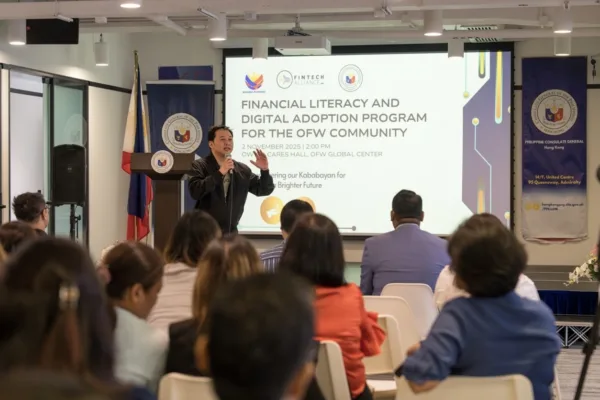by Leira Mananzan, Reporter

Fintech apps are redefining how Filipinos manage, learn, and interact with their finances. In an era where digital transformation is sweeping across industries, the Philippine fintech sector is leveling up financial education. At the forefront is a new movement: gamifying financial literacy — a bold, creative push to equip the next generation with crucial money skills, all while making the experience engaging and fun.
Why gamification? A digital shift in financial education
For decades, financial literacy campaigns have often struggled to capture the attention of young people. Complex jargon, dry presentations, and information overload led to disengagement.
Today, with smartphone penetration soaring and a number of Gen Z consumers craving interactive digital experiences, fintech companies see a unique opportunity: transform financial education into a game that rewards, entertains, and educates all at once.
Gamification is no mere gimmick. It leverages familiar digital strategies—points, badges, leaderboards, and challenges—to teach practical lessons about saving, budgeting, and investing. The result? Higher engagement, better knowledge retention, and, ultimately, healthier financial behaviors nationwide.
The Filipino context: Making FinLit relatable

Financial literacy remains a challenge in the Philippines.
According to the World Bank, only about 25% of Filipino adults possess basic financial knowledge. However, that figure is on the rise, thanks in large part to an upsurge in digital payment usage and emergency savings during the pandemic years. Recognizing the cultural and economic factors at play, many local fintechs are designing apps with Filipino users in mind — making lessons relatable, context-sensitive, and relevant to day-to-day life.
Spotlight: Filipino apps leading the game
- IponIQ — Born out of a mission to bridge the financial literacy gap, IponIQ merges gamification with a Filipino-centric approach. Users progress through levels of lessons, earn points, unlock achievement badges, and see their rank climb on public leaderboards. The app’s modules cover basics—budgeting, saving, debt management—but frame them in relatable local scenarios. Bite-sized reminders and quizzes reinforce learning, while group challenges keep community spirit high.
- Breakthrough: The financial choices we make (BPI Foundation) — BPI Foundation’s flagship app, “Breakthrough,” combines the structure of a traditional board game with immersive digital experiences. Players navigate real-life financial decisions—saving, investing, borrowing—while competing for top spots with in-game assets and tokens. The app includes a financial wellness journal, regular quizzes, and interactive webinars to extend learning beyond the screen.
- WAGI app — Designed for the Filipino youth, the WAGI App incorporates colorful visuals, interactive budgeting tasks, and rewards for completing modules on topics ranging from “Basic Budgeting” to “Stock Investing”. Users are encouraged to set personal savings goals and celebrate milestones, transforming what might be a daunting task into a rewarding adventure.
- Centavion and PitaKabataan — These platforms took top honors at financial literacy innovation challenges by focusing on gamified, engaging educational content for the youth. Their features include interactive storytelling and integrated quizzes, ensuring deeper cognitive engagement.
The science behind gamification — and its real-world impact

Research confirms that game mechanics supercharge engagement and knowledge retention. Challenges, progress tracking, and rewards tap into intrinsic motivation, making lessons not just informative but memorable.
Beyond fun, these digital interventions have the potential for significant social impact:
- Higher engagement: Fintech apps report as much as 700% increases in new user engagement with gamified features.
- Healthier habits: Interactive apps foster goal-setting behaviors — helping users track expenses, increase savings, and approach investments with more confidence.
- Wider inclusion: By making finance accessible and entertaining, gamification lowers the intimidation barrier, especially for underbanked and unbanked youth.
Challenges and opportunities
Of course, not all that glitters is gold. Fintech companies face hurdles — balancing engaging features with responsible financial guidance, handling privacy concerns with personal data, and ensuring their offerings comply with regulations.
The best apps avoid “addictive” features and keep the focus on tangible financial improvement, not just entertainment.
Integration with real-world rewards and partnerships (e.g., with banks, retailers, schools) also magnifies impact, encouraging broader behavioral change.
Looking forward: Is gamification the new normal?
As Gen Z and the upcoming Alpha generation grow increasingly digital, fintech apps that can teach, nudge, and motivate through gamification are poised to shape national financial well-being. While these apps are not a panacea, their potential for social impact is undeniable.
- Expect more personalized, AI-driven challenges tailored to individual goals and habits.
- Community-driven features, such as team savings goals and social impact rewards (like tree planting for hitting milestones), are likely to proliferate as fintechs seek to spur nationwide change.
The race is on. For the Philippine fintech sector, “gaming for green” isn’t just a trend—it’s a transformative tool for shaping financially empowered digital citizens, driven by play, purpose, and progress.








